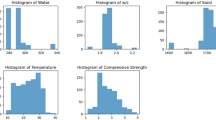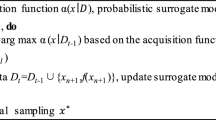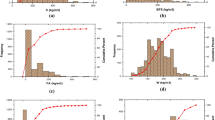Abstract
This study presents a novel artificial intelligence (AI) technique based on two support vector machine (SVM) models and symbiotic organisms search (SOS) algorithm, called “optimized support vector machines with adaptive ensemble weighting” (OSVM-AEW), to predict the shear capacity of reinforced-concrete (RC) deep beams. This ensemble learning-based system combines two supervised learning models—the support vector machine (SVM) and least-squares support vector machine (LS-SVM)—with the SOS optimization algorithm as the optimizer. In OSVM-AEW, SOS is integrated to simultaneously select the optimal parameters of SVM and LS-SVM, and control the coordination process of the learning outputs. Experimental results show that OSVM-AEW achieves the greatest evaluation criteria for coefficient of correlation (0.9620), coefficient of determination (0.9254), mean absolute error (0.3854 MPa), mean absolute percentage error (7.68%), and root-mean-squared error (0.5265 MPa). This paper demonstrates the successful application of OSVM-AEW as an efficient tool for helping structural engineers in the RC deep beams design process.








Similar content being viewed by others
References
Tan KH, Weng LW, Teng S (1997) A strut-and-tie model for deep beams subjected to combined top-and-bottom loading. Struct Eng J 75(13):215–225
Park J-W, Kuchma D (2007) Strut-and-Tie model analysis for strength prediction of deep beams. ACI Struct J 104(6):657–666
Tang C, Tan K (2004) Interactive mechanical model for shear strength of deep beams. J Struct Eng 130(10):1534–1544
Pal M, Deswal S (2011) Support vector regression based shear strength modelling of deep beams. Comput Struct 89(13–14):1430–1439
ACI-318 ACIC (2011) 318-11: Building Code Requirements for Structural Concrete and Commentary. American Concrete Institute
CIRIA-Guide2 CIRaIA (1977) CIRIA Guide 2: The Design of Deep Beams in Reinforced Concrete. CIRIA, Ove Arup and Partners
CSA CSA (1994) Design of concrete structures: structures (design)—a national standard of Canada. CAN-A23.3-94. Toronto
Cheng M-Y, Prayogo D, Wu Y-W (2014) Novel genetic algorithm-based evolutionary support vector machine for optimizing high-performance concrete mixture. J Comput Civil Eng 28(4):06014003
Cheng M-Y, Firdausi PM, Prayogo D (2014) High-performance concrete compressive strength prediction using genetic weighted pyramid operation tree (GWPOT). Eng Appl Artif Intell 29:104–113
Tien Bui D, Nhu V-H, Hoang N-D (2018) Prediction of soil compression coefficient for urban housing project using novel integration machine learning approach of swarm intelligence and multi-layer perceptron neural network. Adv Eng Inform 38:593–604
Hoang N-D, Bui DT (2018) Predicting earthquake-induced soil liquefaction based on a hybridization of kernel Fisher discriminant analysis and a least squares support vector machine: a multi-dataset study. Bull Eng Geol Env 77(1):191–204
Shaik S, Krishna KSR, Abbas M, Ahmed M, Mavaluru D (2018) Applying several soft computing techniques for prediction of bearing capacity of driven piles. Eng Comput. https://doi.org/10.1007/s00366-018-0674-7
Moosazadeh S, Namazi E, Aghababaei H, Marto A, Mohamad H, Hajihassani M (2019) Prediction of building damage induced by tunnelling through an optimized artificial neural network. Eng Comput 35:579–591
Sharma LK, Singh TN (2018) Regression-based models for the prediction of unconfined compressive strength of artificially structured soil. Eng Comput 34(1):175–186
Vapnik VN (1995) The nature of statistical learning theory. Springer, New York
Suykens JAK, Gestel TV, Brabanter JD, Moor BD, Vandewalle J (2002) Least squares support vector machines. World Scientific Publishing Company, Singapore
Tien Bui D, Tuan TA, Hoang N-D, Thanh NQ, Nguyen DB, Van Liem N, Pradhan B (2017) Spatial prediction of rainfall-induced landslides for the Lao Cai area (Vietnam) using a hybrid intelligent approach of least squares support vector machines inference model and artificial bee colony optimization. Landslides 14(2):447–458
Chou J-S, Pham A-D (2013) Enhanced artificial intelligence for ensemble approach to predicting high performance concrete compressive strength. Constr Build Mater 49:554–563
Hancock T, Put R, Coomans D, Vander Heyden Y, Everingham Y (2005) A performance comparison of modern statistical techniques for molecular descriptor selection and retention prediction in chromatographic QSRR studies. Chemom Intell Lab Syst 76(2):185–196
Acar E, Rais-Rohani M (2009) Ensemble of metamodels with optimized weight factors. Struct Multidiscip Optim 37(3):279–294
Wang Y-R, Yu C-Y, Chan H-H (2012) Predicting construction cost and schedule success using artificial neural networks ensemble and support vector machines classification models. Int J Project Manage 30(4):470–478
Chou J-S, Lin C (2013) Predicting disputes in public-private partnership projects: classification and ensemble models. J Comput Civil Eng 27(1):51–60
Chou J-S, Yang K-H, Lin J-Y (2016) Peak shear strength of discrete fiber-reinforced soils computed by machine learning and metaensemble methods. J Comput Civil Eng 30(6):04016036
Prayogo D, Cheng MY, Widjaja J, Ongkowijoyo H, Prayogo H (2017) Prediction of concrete compressive strength from early age test result using an advanced metaheuristic-based machine learning technique. In: ISARC 2017—proceedings of the 34th international symposium on automation and robotics in construction, 2017. pp 856–863
Cheng M-Y, Prayogo D, Wu Y-W (2018) Prediction of permanent deformation in asphalt pavements using a novel symbiotic organisms search–least squares support vector regression. Neural Comput Appl. https://doi.org/10.1007/s00521-018-3426-0
Aljarah I, Al-Zoubi AM, Faris H, Hassonah MA, Mirjalili S, Saadeh H (2018) Simultaneous feature selection and support vector machine optimization using the grasshopper optimization algorithm. Cognitive Comput 10(3):478–495
Faris H, Hassonah MA, Al-Zoubi AM, Mirjalili S, Aljarah I (2018) A multi-verse optimizer approach for feature selection and optimizing SVM parameters based on a robust system architecture. Neural Comput Appl 30(8):2355–2369
Hoang N-D, Pham A-D (2016) Hybrid artificial intelligence approach based on metaheuristic and machine learning for slope stability assessment: a multinational data analysis. Expert Syst Appl 46:60–68
Cheng M-Y, Prayogo D (2014) Symbiotic organisms search: a new metaheuristic optimization algorithm. Comput Struct 139:98–112
Tejani GG, Savsani VJ, Patel VK (2016) Adaptive symbiotic organisms search (SOS) algorithm for structural design optimization. J Comput Des Eng 3(3):226–249
Tejani GG, Savsani VJ, Bureerat S, Patel VK (2018) Topology and size optimization of trusses with static and dynamic bounds by modified symbiotic organisms search. J Comput Civil Eng 32(2):04017085
Tejani GG, Savsani VJ, Patel VK, Mirjalili S (2018) Truss optimization with natural frequency bounds using improved symbiotic organisms search. Knowl Based Syst 143:162–178
Kumar S, Tejani GG, Mirjalili S (2018) Modified symbiotic organisms search for structural optimization. Eng Comput. https://doi.org/10.1007/s00366-018-0662-y
Tejani GG, Pholdee N, Bureerat S, Prayogo D (2018) Multiobjective adaptive symbiotic organisms search for truss optimization problems. Knowl Based Syst 161:398–414
Tejani GG, Pholdee N, Bureerat S, Prayogo D, Gandomi AH (2019) Structural optimization using multi-objective modified adaptive symbiotic organisms search. Expert Syst Appl 125:425–441
Prayogo D, Susanto YTT (2018) Optimizing the prediction accuracy of friction capacity of driven piles in cohesive soil using a novel self-tuning least squares support vector machine. Adv Civil Eng 2018:9
Prayogo D, Cheng M-Y, Wong FT, Tjandra D, Tran D-H (2018) Optimization model for construction project resource leveling using a novel modified symbiotic organisms search. Asian J Civil Eng 19(5):625–638
Cheng M-Y, Prayogo D Modeling the permanent deformation behavior of asphalt mixtures using a novel hybrid computational intelligence. In: ISARC 2016—33rd international symposium on automation and robotics in construction, Auburn, USA, 2016. International association for automation and robotics in construction, pp 1009–1015
Cheng M-Y, Prayogo D, Wu Y-W (2018) A self-tuning least squares support vector machine for estimating the pavement rutting behavior of asphalt mixtures. Soft Comput. https://doi.org/10.1007/s00500-018-3400-x
Ezugwu AE, Prayogo D (2019) Symbiotic organisms search algorithm: theory, recent advances and applications. Expert Syst Appl 119:184–209
Cheng M-Y, Wibowo DK, Prayogo D, Roy AFV (2015) Predicting productivity loss caused by change orders using the evolutionary fuzzy support vector machine inference model. J Civil Eng Manag 21(7):881–892
Bishop CM (2006) Pattern recognition and machine learning (Information Science and Statistics). Springer, New York
Chou J-S, Chiu C-K, Farfoura M, Al-Taharwa I (2011) Optimizing the prediction accuracy of concrete compressive strength based on a comparison of data-mining techniques. J Comput Civil Eng 25(3):242–253
Hoang N-D, Tien Bui D, Liao K-W (2016) Groutability estimation of grouting processes with cement grouts using differential flower pollination optimized support vector machine. Appl Soft Comput 45:173–186
Clark AP (1951) Diagonal tension in reinforced concrete beams. ACI J 48(10):145–156
Kong FK, Robins PJ, Cole DF (1970) Web reinforcement effects on deep beams. ACI J Proc 67(12):1010–1018
Smith KN, Vantsiotis AS (1982) Shear strength of deep beams. ACI J Proc 79(3):201–213
Anderson NS, Ramirez JA (1989) Detailling of stirrup reinforcement. ACI Struct J 86(5):507–515
Tan K-H, Kong F-K, Teng S, Guan L (1995) High-strength concrete deep beams with effective span and shear span variations. ACI Struct J 92(4):395–405
Oh J-K, Shin S-W (2001) Shear strength of reinforced high-strength concrete deep beams. ACI Struct J 98(2):164–173
Aguilar G, Matamoros AB, Parra-Montesinos GJ, Ramirez JA, Wight JK (2002) Experimental evaluation of design procedures for shear strength of deep reinforced concrete beams. ACI Struct J 99(4):539–548
Quintero-Febres CG, Parra-Montesinos G, Wight JK (2006) Strength of struts in deep concrete members designed using Strut-and-Tie method. ACI Struct J 103(4):577–586
Gandomi AH, Alavi AH, Shadmehri DM, Sahab MG (2013) An empirical model for shear capacity of RC deep beams using genetic-simulated annealing. Arch Civil Mech Eng 13(3):354–369
Chang C-C, Lin C-J, Technology (2011) LIBSVM: a library for support vector machines. ACM Trans Intell Syst 2(3):27
De Brabanter K, Karsmakers P, Ojeda F, Alzate C, De Brabanter J, Pelckmans K, De Moor B, Vandewalle J, Suykens JA (2010) LS-SVMlab toolbox user’s guide: version 1.7. Katholieke Universiteit Leuven
Hsu CW, Chang CC, Lin CJ (2003) A practical guide to support vector classification. Technical report, Department of Computer Science and Information Engineering, National Taiwan University, Taipei. http://www.csie.ntu.edu.tw/cjlin/libsvm/
Acknowledgments
The authors gratefully acknowledge that the present research is supported by The Ministry of Research, Technology, and Higher Education of the Republic of Indonesia (No: 123.58/D2.3/KP/2018) under the “World Class Professor” (WCP) Research Grant Scheme.
Author information
Authors and Affiliations
Corresponding author
Additional information
Publisher's Note
Springer Nature remains neutral with regard to jurisdictional claims in published maps and institutional affiliations.
Electronic supplementary material
Below is the link to the electronic supplementary material.
Rights and permissions
About this article
Cite this article
Prayogo, D., Cheng, MY., Wu, YW. et al. Combining machine learning models via adaptive ensemble weighting for prediction of shear capacity of reinforced-concrete deep beams. Engineering with Computers 36, 1135–1153 (2020). https://doi.org/10.1007/s00366-019-00753-w
Received:
Accepted:
Published:
Issue Date:
DOI: https://doi.org/10.1007/s00366-019-00753-w




